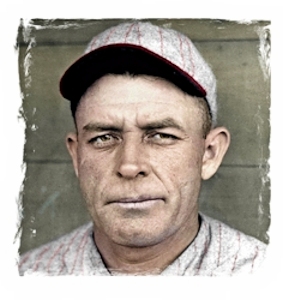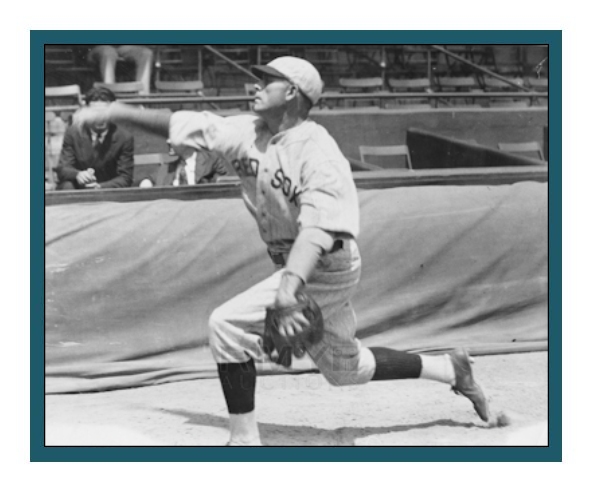|
“FENWAY'S BEST PLAYERS”  |
|||
In 1928 pitcher Ed Morris got his big-league chance with the struggling last-place Red Sox. The 28-year-old rookie recorded his first victory on May 3rd with an impressive four-hitter over the Philadelphia Athletics. Though he didn’t join the starting rotation until May, he sported a 17-11 won-lost mark after an August 25th victory over the St. Louis Browns. But he mysteriously lost his effectiveness and dropped his next four starts before winning his final one of the year. During this time his ERA jumped 40 points to a final mark of 3.53. Despite his late-season slump, Morris accounted for 33% of the Red Sox’ meager 57 wins, by far the highest percentage among the league’s hurlers. He also ended up in the American League top 10 in ERA, strikeouts, and fewest hits allowed per nine innings. A victim of poor offensive support, his teammates failed to score more than three runs in 11 of the 13 losses he suffered as a starter. Morris was a candidate for the American League "Most Valuable Player" Award, and he was the second-leading vote-getter among the league’s hurlers, behind 23-game-winner Waite Hoyt of the Yankees. Although the "Rookie of the Year" Award hadn’t yet come into existence, he was arguably the top rookie in the American League in 1928 and was selected as the right-handed pitcher on The Sporting News Rookie All-Star Team. In 1929 Morris' performance fell off and he began experiencing arm problems as the Red Sox again finished in the American League cellar. For the year, his 14 victories again led the staff, but he also lost 14 times and his ERA rose to 4.45, well above the league average. In preparation for the 1930 season, "Big Ed" briefly flirted with another off-season activity for keeping in shape – professional boxing and applied for a boxing license. Unfortunately, Commissioner Kenesaw Mountain Landis short-circuited his heavyweight championship ambitions. Possibly due to the loss of projected boxing revenue, "Big Ed" was a salary holdout when the Red Sox 1930 spring training camp opened. He decided to drive down to spring training, watch an early workout, and ended up signing for a modest $500 raise. Morris seemed to be hitting his stride when he threw a brilliant two-hitter to beat the St. Louis Brown, but he was ineffective in his next two starts. His next start was on June 4th and resulted in a 5 to 4, 10-inning complete-game triumph over Cleveland. He followed that effort up with a well-pitched 1-0 loss in Detroit on June 8th, before missing another three weeks of action. Arm miseries cropped up and continued to plague him until he was shut down for the year in mid-August. For the 1930 season, he pitched only 18 times (nine starts). His won-lost record was a disappointing 4-9 although his 4.13 ERA was better than the league average. One positive aspect of the 1930 campaign was that he hit .316 with a robust .526 slugging average. In 1931 in his first start of the season against the Yankees on April 25th, he held the Bombers to four hits and two earned runs before leaving with the score tied and two outs in the eighth inning. He pitched a good game against the Senators in his next appearance, although he again failed to get the decision. Though he still hadn’t cracked the victory column he had an excellent 2.01 earned run and was starting to look like the Big Ed Morris of old, when a vicious batting practice line drive broke his toe. He returned to action after more than three weeks on the shelf to win three straight starts after an initial loss. After coming back, he was consigned back to the bullpen after yielding five runs to the Philadelphia A’s in one-third inning of work in the first game of a July 4th doubleheader. But this was likely to have occurred in the wake of a colorful Big Ed Morris escapade. According to the story, "Big Ed" came across a temporarily unmanned elevator in the St. Louis hotel where the team was staying and proceeded to hi-jack the car. Upon returning to his post to find the car missing, the operator summoned a pair of house detectives who began chasing after him in another elevator. "Big Ed" would stop the car at every floor just long enough to bellow out a loud rebel yell. When the detectives finally caught up with him, they wrestled him to the ground, wrenching his shoulder in the fracas. Pitching mostly in relief with an occasional start the rest of the way, Morris finished the season with a 5-7 won-lost mark and a mediocre 4.75 ERA. As winter began giving way to spring in 1932, "Big Ed" was determined to make a big comeback and reclaim his spot at the top of the rotation. Some of his friends planned a fish fry/peanut boil as a going-away party for him the day before he was scheduled to leave for spring training. Quantities of prohibition-era alcohol were present, and during a scuffle, "Big Ed" was stabbed and ended up in the hospital. The cause of the brawl and the role of the combatants was a matter of some conjecture. In the differing versions, Morris was variously portrayed as the instigator as well as an innocent bystander. Initially, doctors had given him an even chance to recover, but he died on Thursday, March 3, 1932, as a result of the stabbing.
|
|||

